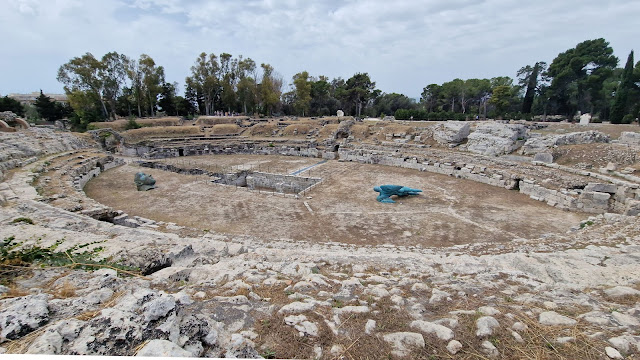At the centre of the arena is a quadrangular basin. Probably a sort of trap door that served as a support for the shows of the amphitheatre
These are the ruins of the altar of Hieron, the largest stone altar built in the Greek world. It was dedicated to Zeus 'eleutherios'. It is almost 200 m long and according to tradition, up to 450 bulls were sacrificed here on the occasion of the feasts that commemorated the expulsion of the tyrant Trasibulos.
This is the latomia del paradiso, the Paradise stone quarry. In ancient times it looked very different and was a place of work and a prison for slaves. Nowadays it's a beautiful garden with vegetation made of Mediterranean and exotic plants: orange and lemon trees but also palms and ficus trees.
Inside the quarry it's also possible to see some caves. One of them is the 'Grotta dei cordari' the ropemakers cave because this crafmen's corporation worked here for centuries.
But the most famous cave in Syracuse is the 'ear of Dionysius'. This grotto has a height of 23 m and is deep about 60 m. Its name derives from the shape that resembles a human ear. A famous story, told from the painter Caravaggio during his Sicilian period, remembers the greek tyrant Dionysius who used this cave as prison for his enemies. Thanks to the peculiarity of the cave which expanded the voices, he could spy his prisoners.
The "Ear" was used in the latest film, Indiana Jones and the Dial of Destiny, as the tomb of Archimedes, as it was considered more dramatic than the real thing which is only a couple of kilometres away.
A different view of the quarry.
Unfortunately the Greek Theatre was being used as a theatre for various productions through the summer and the original seats and terracing were covered for the public to use without damaging the originals. So this is what we could see.
The ancient Greek theatre was built between the
5th and 3rd century B.C. It could probably hold 12,000-14,000 spectators.
This impressive monument dug into the rock of the Temenites
hill. This is the reason why it's still partly preserved in the lower part of
the cavea while the upper part is missing: this part was built with stone
blocks which were reused during the medieval period.
Walking around the top of the theatre there was a wonderful view of the quarry, in some areas looking like a scene from Planet of the Apes.
This beautiful fountain: the nympheum, provided water to the area and there were also the remains of some tombs dating back to the early Christian age.
As we walked back down we passed this house.This is also an historical monument: a water mill dating back to the 18th century.
That was the end of our visit and it was getting hot and time for lunch and a well earned drink.






















No comments:
Post a Comment